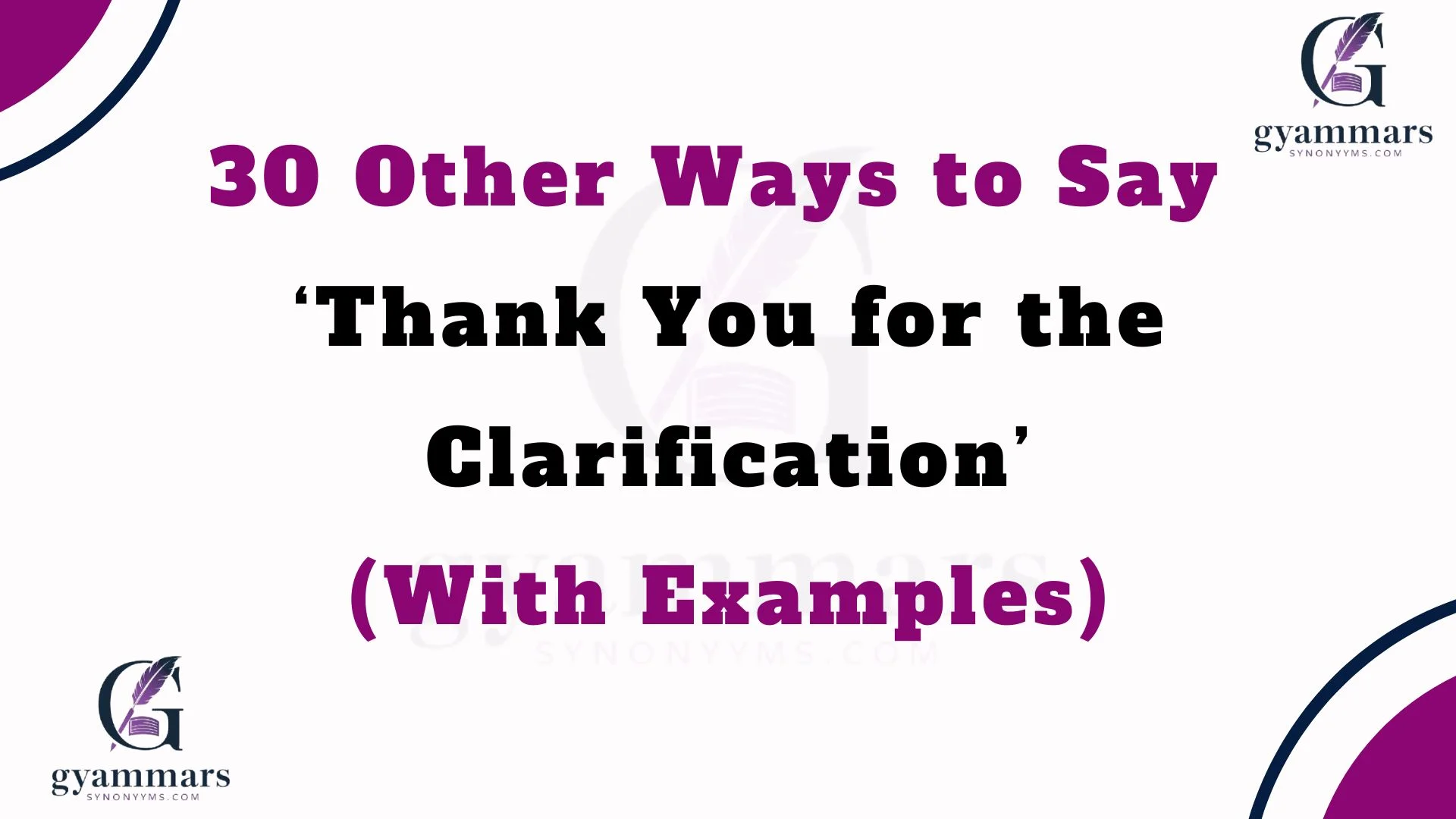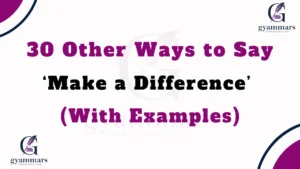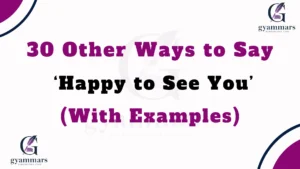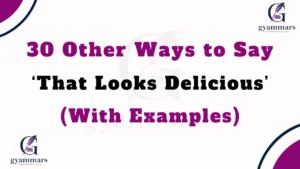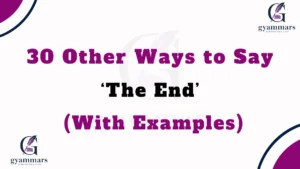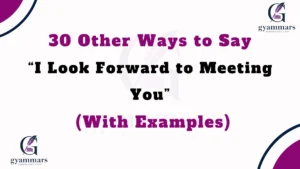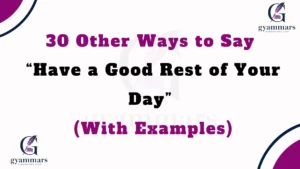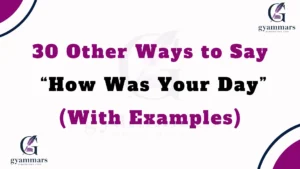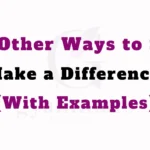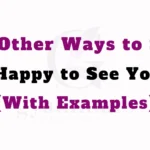Sometimes, it’s not just about saying “Thank you for the clarification”—it’s about showing genuine warmth, care, and appreciation in how you respond. Whether you’re writing an email, chatting with a colleague, or responding in a personal conversation, finding the right words can make your message feel more thoughtful and personal. This guide gives you 30 meaningful alternatives, complete with definitions, examples, and best uses so you can express yourself with both professionalism and kindness.
What Does “Thank You for the Clarification” Mean?
At its core, “Thank you for the clarification” is a way of expressing gratitude when someone takes the time to explain something more clearly. It’s about acknowledging the effort the other person made to make things easier for you to understand.
Is It Professional/Polite to Say “Thank You for the Clarification”?
Yes—this phrase is both polite and professional. It shows respect, appreciation, and attentiveness. However, in certain contexts, using alternatives can make your message feel warmer, friendlier, or more natural depending on the situation.
Pros or Cons of Using “Thank You for the Clarification”
Pros:
- Universally understood and polite
- Works in professional and personal contexts
- Neutral, safe, and clear
Cons:
- Can sound stiff or robotic if overused
- May not always match the tone of a casual or heartfelt exchange
- Lacks personal warmth compared to other alternatives
Synonyms For ‘Thank You for the Clarification’
- I appreciate you explaining that
- Thanks for clearing that up
- I’m glad you explained that
- That makes more sense now
- Thanks for walking me through that
- I value your explanation
- Thanks for helping me understand
- I see what you mean now
- I appreciate the detailed explanation
- Thanks for shedding light on that
- I’m grateful for your clarification
- That clears it up nicely
- I’m glad we went over that
- Thanks for making that clear
- I appreciate the clarity
- That explanation really helps
- Thanks for putting it into perspective
- I see it more clearly now
- Thanks for taking the time to explain
- That really clarifies things for me
- I appreciate your patience in explaining
- That was very helpful, thanks
- I’m thankful for your explanation
- Thanks for breaking it down for me
- I value the clarity you’ve provided
- That makes everything a lot clearer
- Thanks for pointing that out
- I understand better now, thanks
- That explanation clears up my confusion
- Thanks, that really helps me move forward
1. I appreciate you explaining that
Definition: Expresses gratitude for someone taking time to clarify.
Explanation: This feels warm and direct without being overly formal.
Scenario Example: “I appreciate you explaining that—it helps me see the bigger picture.”
Best Use: When you want to sound friendly but still professional.
Tone: Warm and polite.
Additional Notes: Works well in both casual and workplace settings.
2. Thanks for clearing that up
Definition: A casual way to acknowledge clarification.
Explanation: Light and conversational, perfect for everyday chats.
Scenario Example: “Oh, thanks for clearing that up—I wasn’t sure what you meant.”
Best Use: Informal conversations with coworkers, friends, or peers.
Tone: Relaxed, conversational.
Additional Notes: Best avoided in highly formal situations.
3. I’m glad you explained that
Definition: Highlights relief and appreciation for clarification.
Explanation: Shows that the explanation was valuable and needed.
Scenario Example: “I’m glad you explained that—it makes total sense now.”
Best Use: When clarification brings comfort or resolution.
Tone: Appreciative and slightly personal.
Additional Notes: Adds an emotional layer of gratitude.
4. That makes more sense now
Definition: Acknowledges clarity after confusion.
Explanation: Focuses on understanding rather than just gratitude.
Scenario Example: “Ah, that makes more sense now—thanks for breaking it down.”
Best Use: When the focus is on understanding a complex point.
Tone: Neutral yet appreciative.
Additional Notes: Great for technical or detailed explanations.
5. Thanks for walking me through that
Definition: Shows appreciation for a step-by-step explanation.
Explanation: Emphasizes the effort the other person put into explaining.
Scenario Example: “Thanks for walking me through that—I really get it now.”
Best Use: When someone guides you patiently.
Tone: Warm, slightly casual.
Additional Notes: Best for mentorship or collaborative contexts.
6. I value your explanation
Definition: A more formal acknowledgment of someone’s effort.
Explanation: Emphasizes that their time and input are valuable.
Scenario Example: “I value your explanation—it helps me move forward with confidence.”
Best Use: Professional settings where respect must be highlighted.
Tone: Respectful, professional.
Additional Notes: Works best in emails and formal communication.
7. Thanks for helping me understand
Definition: Shows gratitude for the role in improving your understanding.
Explanation: Focuses on personal growth and clarity gained.
Scenario Example: “Thanks for helping me understand—I was a bit lost before.”
Best Use: Ideal for learning environments or collaborative projects.
Tone: Warm, appreciative.
Additional Notes: Works well when admitting confusion.
8. I see what you mean now
Definition: Expresses understanding after receiving clarification.
Explanation: Indicates progress in comprehension.
Scenario Example: “Got it—I see what you mean now, thanks for explaining.”
Best Use: Casual conversations or quick replies.
Tone: Friendly and understanding.
Additional Notes: Adds a sense of mutual connection.
9. I appreciate the detailed explanation
Definition: Acknowledges effort behind giving details.
Explanation: Perfect for when someone goes above and beyond.
Scenario Example: “I appreciate the detailed explanation—it really clears things up.”
Best Use: Professional emails or technical settings.
Tone: Formal and respectful.
Additional Notes: Highlights effort, not just clarity.
10. Thanks for shedding light on that
Definition: A metaphorical way of saying thanks for clarity.
Explanation: Creates a softer, almost poetic tone.
Scenario Example: “Thanks for shedding light on that—I hadn’t seen it that way.”
Best Use: Semi-formal or conversational exchanges.
Tone: Thoughtful, slightly creative.
Additional Notes: Good when acknowledging a new perspective.
11. I’m grateful for your clarification
Definition: Expresses heartfelt appreciation for being guided toward clarity.
Explanation: Slightly more personal than the standard phrase, showing deeper gratitude.
Scenario Example: “I’m grateful for your clarification—it saves me a lot of time.”
Best Use: When the explanation has a significant positive impact.
Tone: Warm, appreciative.
Additional Notes: More emotional than neutral “thanks.”
12. That clears it up nicely
Definition: A casual, friendly acknowledgment of understanding.
Explanation: Adds a touch of lightness, making it conversational.
Scenario Example: “That clears it up nicely—thanks for breaking it down for me.”
Best Use: Informal exchanges or quick responses.
Tone: Relaxed, upbeat.
Additional Notes: Not ideal for highly formal business communication.
13. I’m glad we went over that
Definition: Emphasizes satisfaction in discussing the clarification.
Explanation: Shows gratitude while also highlighting relief.
Scenario Example: “I’m glad we went over that—it makes much more sense now.”
Best Use: Meetings, team discussions, or collaborative problem-solving.
Tone: Appreciative, reflective.
Additional Notes: Works best in spoken conversations.
14. Thanks for making that clear
Definition: A straightforward, polite way of showing gratitude.
Explanation: Slightly more casual than the main phrase but still respectful.
Scenario Example: “Thanks for making that clear—I understand completely now.”
Best Use: Email or in-person communication when clarity is achieved.
Tone: Neutral to warm.
Additional Notes: Flexible for personal or professional use.
15. I appreciate the clarity
Definition: Expresses gratitude for someone simplifying confusion.
Explanation: Short and formal, suitable for professional tones.
Scenario Example: “I appreciate the clarity—it really helps with next steps.”
Best Use: Business emails or reports.
Tone: Formal, respectful.
Additional Notes: Great for professional documentation.
16. That explanation really helps
Definition: Acknowledges the usefulness of an explanation.
Explanation: Emphasizes impact rather than just the act of clarifying.
Scenario Example: “That explanation really helps—I know how to move forward now.”
Best Use: Work settings, training, or mentorship.
Tone: Appreciative, slightly casual.
Additional Notes: Conveys action-based gratitude.
17. Thanks for putting it into perspective
Definition: Gratitude for reshaping or contextualizing information.
Explanation: Recognizes not just clarity, but also a new angle of understanding.
Scenario Example: “Thanks for putting it into perspective—I hadn’t thought of it like that.”
Best Use: When someone provides new insight or framing.
Tone: Thoughtful, reflective.
Additional Notes: Ideal for deeper conversations.
18. I see it more clearly now
Definition: Acknowledges the shift from confusion to understanding.
Explanation: Focuses on personal learning rather than the other’s effort.
Scenario Example: “I see it more clearly now—thanks for pointing that out.”
Best Use: Personal or professional conversations.
Tone: Neutral, appreciative.
Additional Notes: Adds a sense of personal growth.
19. Thanks for taking the time to explain
Definition: Acknowledges both the explanation and the effort behind it.
Explanation: Shows respect for someone’s time investment.
Scenario Example: “Thanks for taking the time to explain—I know you’re busy.”
Best Use: Work emails, formal discussions.
Tone: Respectful, professional.
Additional Notes: Excellent for superiors or mentors.
20. That really clarifies things for me
Definition: A direct, clear acknowledgment of improved understanding.
Explanation: Puts focus on the benefit you received.
Scenario Example: “That really clarifies things for me—I appreciate it.”
Best Use: When you want to keep it simple but personal.
Tone: Warm, professional.
Additional Notes: Versatile and polite.
21. I appreciate your patience in explaining
Definition: Highlights both patience and effort given in clarification.
Explanation: Useful when the person had to repeat or simplify.
Scenario Example: “I appreciate your patience in explaining—it means a lot.”
Best Use: When someone goes out of their way to guide you.
Tone: Respectful, warm.
Additional Notes: Adds humility and gratitude.
22. That was very helpful, thanks
Definition: Acknowledges usefulness in addition to clarity.
Explanation: Simple, polite, and professional.
Scenario Example: “That was very helpful, thanks—it’s all much clearer now.”
Best Use: Professional conversations, training sessions.
Tone: Neutral to warm.
Additional Notes: A safe choice in most situations.
23. I’m thankful for your explanation
Definition: A slightly more heartfelt version of thanks.
Explanation: Expresses appreciation with more emotion than formality.
Scenario Example: “I’m thankful for your explanation—it makes all the difference.”
Best Use: Personal or semi-professional settings.
Tone: Sincere, appreciative.
Additional Notes: Stronger than a simple “thanks.”
Also Read This : 30 Other Ways to Say “You’re Proud of Someone” (With Examples)
24. Thanks for breaking it down for me
Definition: Gratitude for simplifying something complex.
Explanation: Shows recognition of the effort to make it digestible.
Scenario Example: “Thanks for breaking it down for me—it’s much easier to follow.”
Best Use: Casual work discussions, learning environments.
Tone: Friendly, approachable.
Additional Notes: Great for informal exchanges.
25. I value the clarity you’ve provided
Definition: Shows respect and acknowledgment of the value of explanation.
Explanation: Slightly formal and professional.
Scenario Example: “I value the clarity you’ve provided—it helps the team move forward.”
Best Use: Workplace communication.
Tone: Formal, respectful.
Additional Notes: Best in emails and written contexts.
26. That makes everything a lot clearer
Definition: A conversational way of highlighting understanding.
Explanation: Emphasizes the improvement in comprehension.
Scenario Example: “That makes everything a lot clearer—thanks for explaining.”
Best Use: Casual or semi-formal conversations.
Tone: Appreciative, conversational.
Additional Notes: Friendly but still professional enough.
27. Thanks for pointing that out
Definition: Acknowledges a specific clarification or correction.
Explanation: Perfect for smaller details or corrections.
Scenario Example: “Thanks for pointing that out—I’ll adjust accordingly.”
Best Use: Emails, teamwork, or editing contexts.
Tone: Polite, professional.
Additional Notes: Keeps it short and focused.
28. I understand better now, thanks
Definition: Combines acknowledgment of clarity and gratitude.
Explanation: Focuses on your improved understanding.
Scenario Example: “I understand better now, thanks for explaining that.”
Best Use: Friendly or neutral settings.
Tone: Warm, conversational.
Additional Notes: Simple and to the point.
29. That explanation clears up my confusion
Definition: Direct acknowledgment of resolved confusion.
Explanation: Highlights the transition from misunderstanding to clarity.
Scenario Example: “That explanation clears up my confusion—I appreciate your help.”
Best Use: When you’ve struggled with a concept and now understand.
Tone: Honest, appreciative.
Additional Notes: Works well in learning or technical discussions.
30. Thanks, that really helps me move forward
Definition: Gratitude that highlights progress enabled by clarification.
Explanation: Recognizes both clarity and actionability.
Scenario Example: “Thanks, that really helps me move forward with my work.”
Best Use: Project updates, professional settings.
Tone: Professional, forward-looking.
Additional Notes: Great for showing appreciation and momentum.
Conclusion
Finding the right words can transform a simple thank-you into something meaningful and personal. While “Thank you for the clarification” is always polite and professional, using these 30 thoughtful alternatives lets you adapt your tone—whether you want to sound formal, casual, warm, or deeply appreciative. Small shifts in phrasing can make your communication feel more human, genuine, and kind.

“Emma Rose at Grammar Synonyms is your go-to expert for everything related to language and expression. Whether you’re refining your grammar, searching for the perfect synonym, or looking for creative ways to improve your writing, Emma Rose provides the tools and inspiration you need. With a wide range of resources designed to elevate your communication, Grammar Synonyms helps you find just the right words to make every sentence shine.
